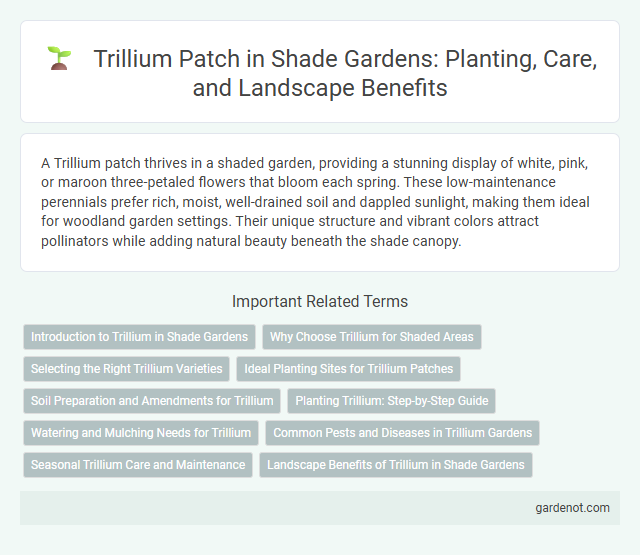A Trillium patch thrives in a shaded garden, providing a stunning display of white, pink, or maroon three-petaled flowers that bloom each spring. These low-maintenance perennials prefer rich, moist, well-drained soil and dappled sunlight, making them ideal for woodland garden settings. Their unique structure and vibrant colors attract pollinators while adding natural beauty beneath the shade canopy.
Introduction to Trillium in Shade Gardens
Trillium thrives in shade gardens due to its preference for moist, well-drained soils and dappled sunlight, making it an ideal understory plant. This perennial wildflower offers distinctive three-petaled blooms and broad, lush leaves that enhance garden biodiversity and aesthetic appeal. Planting trillium patches supports native pollinators and contributes to a natural woodland garden atmosphere.
Why Choose Trillium for Shaded Areas
Trilliums thrive in shaded garden spots due to their natural adaptation to woodland environments, making them ideal for shade gardens. Their ability to bloom early in spring before the tree canopy fully develops allows them to maximize light absorption in low-light conditions. Choosing trilliums enhances garden biodiversity while providing elegant, three-petaled flowers that flourish in nutrient-rich, moist soil typically found in shaded areas.
Selecting the Right Trillium Varieties
Selecting the right Trillium varieties for a shade garden involves understanding their specific light, soil, and moisture preferences to ensure optimal growth and bloom. Popular species like Trillium grandiflorum thrive in rich, well-drained woodland soils with dappled shade, while Trillium erectum prefers slightly moister conditions and partial shade. Considering bloom time and flower color variations among species such as Trillium cernuum and Trillium sulcatum enhances the aesthetic diversity of the shade garden throughout spring.
Ideal Planting Sites for Trillium Patches
Trillium patches thrive in rich, moist, well-drained soils enriched with organic matter, commonly found in deciduous or mixed hardwood forests. Ideal planting sites offer dappled shade with protection from harsh afternoon sun, mimicking the natural understory environment. Consistent moisture and minimal soil disturbance enhance growth and help establish vibrant, sustainable trillium colonies.
Soil Preparation and Amendments for Trillium
Trillium thrives in well-drained, humus-rich soil with a slightly acidic to neutral pH, ideally between 5.5 and 7.0. Incorporating organic matter such as leaf mold, compost, or well-rotted manure enhances soil texture and nutrient availability, promoting healthy root development. Proper soil preparation includes loosening the top 6-8 inches and ensuring consistent moisture retention without waterlogging to support vigorous Trillium growth.
Planting Trillium: Step-by-Step Guide
Planting trillium in a shade garden requires selecting a moist, well-drained soil rich in organic matter, ideally under deciduous trees where dappled sunlight prevails. Begin by planting rhizomes or tubers 2 to 3 inches deep in early spring or fall, spacing them about 12 inches apart to allow natural clumping and spreading. Maintain consistent moisture without waterlogging and apply a layer of mulch to preserve soil temperature and moisture, fostering healthy growth and vibrant spring blooms.
Watering and Mulching Needs for Trillium
Trillium patches thrive in consistently moist, well-drained soil, requiring regular watering to maintain hydration, especially during dry spells. Applying a 2-3 inch layer of organic mulch, such as shredded leaves or bark, helps retain soil moisture, regulate temperature, and suppress weeds. Proper watering combined with mulching fosters healthy growth and vibrant blooms in shade garden environments.
Common Pests and Diseases in Trillium Gardens
Trillium patches in shade gardens often face threats from slugs, deer, and aphids, which can cause significant foliage damage. Common diseases include leaf spot, caused by fungal pathogens, and root rot, particularly in poorly drained soils. Preventative measures such as proper spacing, mulching, and natural pest deterrents help maintain healthy Trillium growth.
Seasonal Trillium Care and Maintenance
Trillium patches thrive in well-drained, rich organic soil with consistent moisture throughout the growing season. Seasonal Trillium care involves mulching in spring to retain moisture and protect emerging shoots, followed by careful removal of spent foliage in late summer to prevent disease. Regular monitoring for pests like slugs and providing partial to full shade ensures healthy growth and vibrant blooms year after year.
Landscape Benefits of Trillium in Shade Gardens
Trillium patches enhance shade gardens by providing robust ground cover that suppresses weeds and retains soil moisture, contributing to healthier plant ecosystems. Their distinctive three-petaled flowers and lush foliage create visual interest and seasonal variation, enriching the garden's biodiversity. Trilliums are native perennials adapted to low-light conditions, making them ideal for sustainable, low-maintenance landscaping in shaded woodland areas.
Trillium patch Infographic

 gardenot.com
gardenot.com